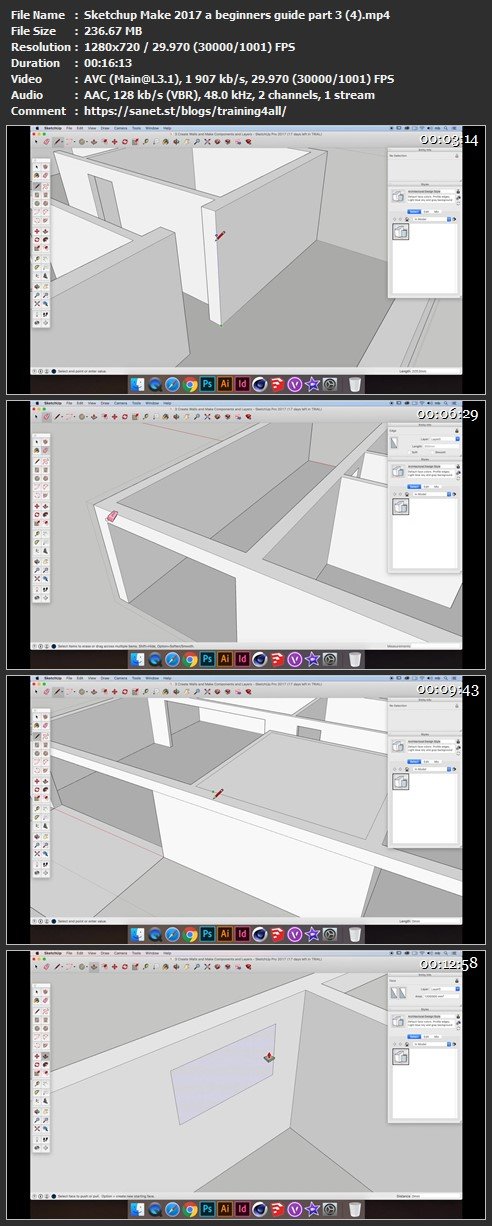

When I create a model for a plan, I actually have several copies of the parts in the model space so I select just the assembled model before running the cutlist so I don’t get multiples of the parts in the list. The processing should be nearly instantaneous. When you click Run, the extension will process through the model and generate the parts layouts as well as the cutlist. These settings have no impact on the cutlist, though. Under the Layout tab you’ll find more settings which are useful for determining how the extension deals with the solid wood and sheet material components in the model for the layout output. Click on the button and a window opens to give you some information about the settings in that line. The question marks in the blue circles are help buttons. After you make any changes to the settings, you can save them so you don’t have to make those changes again. If your components don’t include words from either of these lists, they are assumed to be solid wood.
#SKETCHUP MAKE 2017 TUTORIAL WINDOWS#
You can add words to these windows as I’ve done in the following image. The text boxes after ‘Part Words’ and ‘Sheet Material Words’ are for words you’ve used in your component definition names that help the extension sort the components into the right sections of the list. There are sections for selecting the things you want to show in the output and determining how they look. The first window of the user interface looks like this.

#SKETCHUP MAKE 2017 TUTORIAL INSTALL#
Access the Extension Warehouse directly from SketchUp and install it automatically. After you’ve installed it you’ll want to do a little bit of setup to customize it for your use. As you can see in the X-ray view, all the wooden parts are fully detailed with tenons, dovetails, and so on.ĬutList was written by Steve Racz and is freely available in the Extension Warehouse. I used this model of a colonial stand up desk as an example in the video. The more precisely you create your model, the more accurate your cutlist will be. Remember, this is a computer program and GIGO(garbage in, garbage out) applies. Negative spaces such as mortises and the spaces between the dovetail pins don’t come into play with the cutlist so you can include them or not as you desire. Since the cutlist shows the overall dimensions of the parts in your project, you’ll need to include details such as tenons and dovetails. Of course, you’ll want to have detailed your model and drawn it accurately. You’ll see how that comes into play in the video.

(You can go back and rename groups after creation if you wish but it takes extra steps.) Another benefit to components as related to the cutlist is that you can change the axes to align them to angled parts. If all the parts are named ‘Group’, it’s hard to know which is which. That makes it easier to know which part’s dimensions you’re looking at. First, you are prompted to name them as you create them. In regards to creating a cutlist, there are two primary benefits of components. I advocate using components for a long list of reasons. It does ignore ungrouped geometry so you need to consider that. As with all of them, CutList generates the list based on the dimensions of the bounding boxes of the components and groups in your model. The one I prefer is simply called CutList. Many of them seem like they are aimed more at the kitchen and bath cabinet makers. I’ve tried a few of them and found they all do what they do quite well. There are a number of extensions for SketchUp that will create cutlists. I know a woodworker and SketchUp user who would draw his project and then sit down with the Tape Measure tool, paper, and pencil and make up his cutlist. Now, a cutlist isn’t that difficult to create by hand. It is handy, though, to have a cutlist so I have the overall sizes of the parts at hand as well as a shopping list when I go to the store for parts. For my own use, a few images exported from the SketchUp file usually suffice. I use SketchUp and LayOut to make the digital and printed plans for many of the projects featured in Fine Woodworking Magazine. Typically I find that I don’t need a formal plan for myself, although it’s certainly possible to make one. Once you have the model drawn, though, what next? Well, after you’ve drawn the model, and have the visible details worked out, you can add the joinery and other bits to the model to create a plan to take to the shop. You can sketch out your ideas to get a good feel for how they will look making it easy for you and your client to get on the same page with a design. You’ve probably already discovered that SketchUp is a great tool for designing your project.


 0 kommentar(er)
0 kommentar(er)
